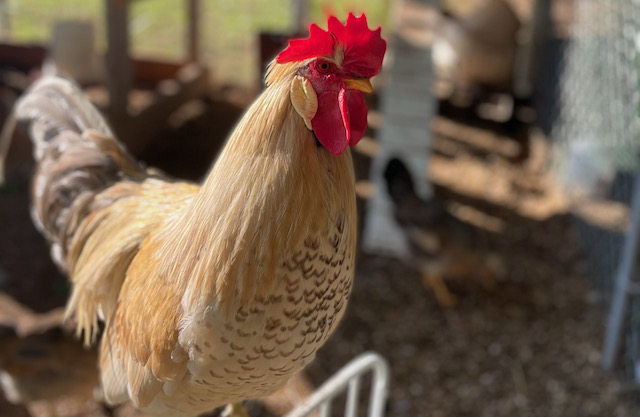As my husband and I started talking about getting chickens, we created our vision: free range chickens that laid lots of eggs.
As you know, the first round of chickens were free range but they stopped laying eggs in our coop. Our second round has been confined to our run and the quantity of eggs has slowly been increasing. But, the free range part isn’t going so well. We have two issues, first our dog JacX who believes her job is to catch the chickens and bring them to my husband (Mike is working on addressing this issue with the dog trainer).
But, our other issue is Oden, the rooster. The reason we have a rooster is twofold: first, roosters will protect the hens, and second, having a rooster allows me to continue the bloodline without purchasing additional chicks.
Oden is very good at protecting his hens. But about a month ago, my husband went to put them in for the night, and Oden wasn’t quite ready to turn in. My husband gave him a gentle nudge toward the coop, which Oden didn’t appreciate. His response was to flog my husband. While my husband didn’t dwell on the incident, Oden apparently isn’t over it yet. He now likes to strut up to me or my husband to challenge us. Fortunately, Oden has learned the word “No.” But it has definitely reduced the fun in caring for the chickens. In fact, I can’t be in the coop when he is walking around, as he will come up and try to challenge me (he hasn’t tried to flog me yet).
Based on our Chicken Values, I’ve been wondering if we have a Right Seat, Wrong Chicken problem.
The phrase “Right Person, Right Seat” comes from Jim Collins’ 2001 bestseller Good to Great. The “Right Person” is someone who shares your organization’s core values. The “Right Seat” means that person is using the skills and talents they were born with. When implementing EOS, I teach my clients that in order to achieve their vision, they need 100% of the individuals in their organization to be “Right People, Right Seat.” If you don’t have that, the organization’s performance will suffer. Allow me to explain.
Let’s say your situation is Right Person, Wrong Seat. You have someone who shares your company’s core values. They fit your culture like a glove, but they aren’t doing a job that is in line with their skills and abilities. Typically, management makes excuses for the person by saying things like, ”He has been here since the beginning,” or “I really want her to finish her career with us.” So, you either tolerate underperformance or begin to create workarounds to ensure the organization still meets its goals while keeping that person in his/her seat. That results in inefficiency, chaos and reduced performance.
The other challenge you may face is Wrong Person, Right Seat. This is someone who is really good at the job but doesn’t demonstrate the organization’s core values. I’ve witnessed this with a really strong salesperson who will win at all costs, even if it means sacrificing the company’s core values. It might also happen when you have a very knowledgeable technical person in a key role, or possessing a unique understanding of the product or service being provided. Organizations often feel they can’t possibly let that person go, because they will lose their competitive edge, and if that employee were then hired by a competitor, the company’s secrets could be shared. But I have seen first-hand that letting a Wrong Person go actually liberates other individuals in the organization to step up and fill the void. And oftentimes, after the person is gone, the leadership team will start to hear stories about how this person was eroding the culture and the company’s reputation.
If you sense that someone in your organization is either the wrong person in the right seat, or the right person in the wrong seat, I challenge you to do something about it. Achieving your vision requires that you address those issues within the organization. If you aren’t sure what to do or how to approach this issue, I can help you get clarity on how best to address it for the greater good of your organization.
Oh, and did I mention that one of my 18 week old chickens is a rooster…

